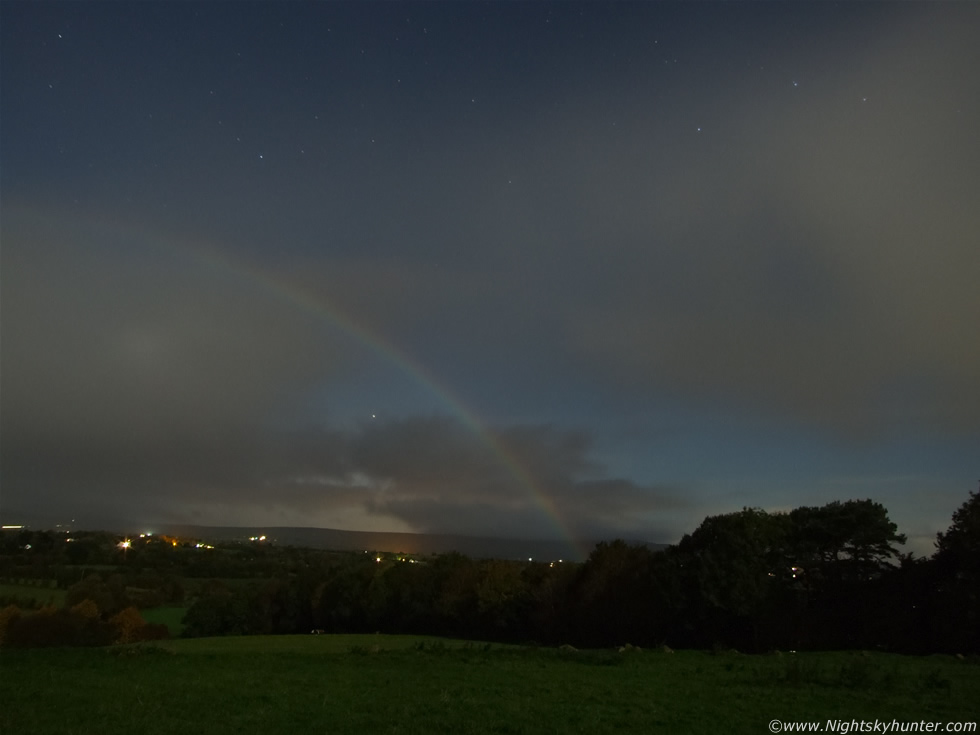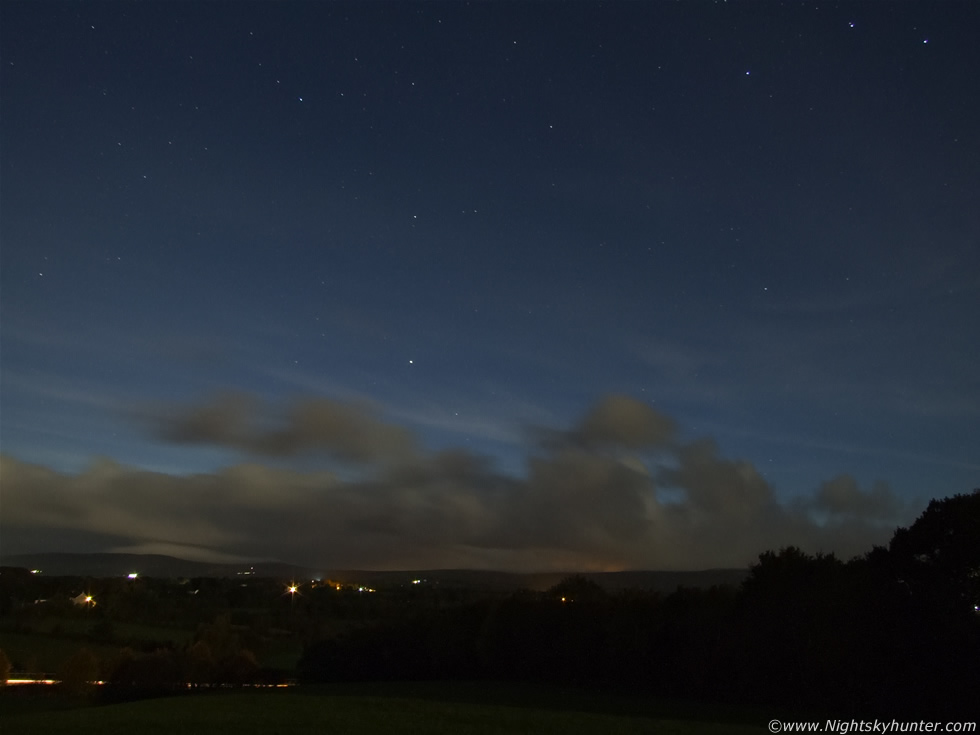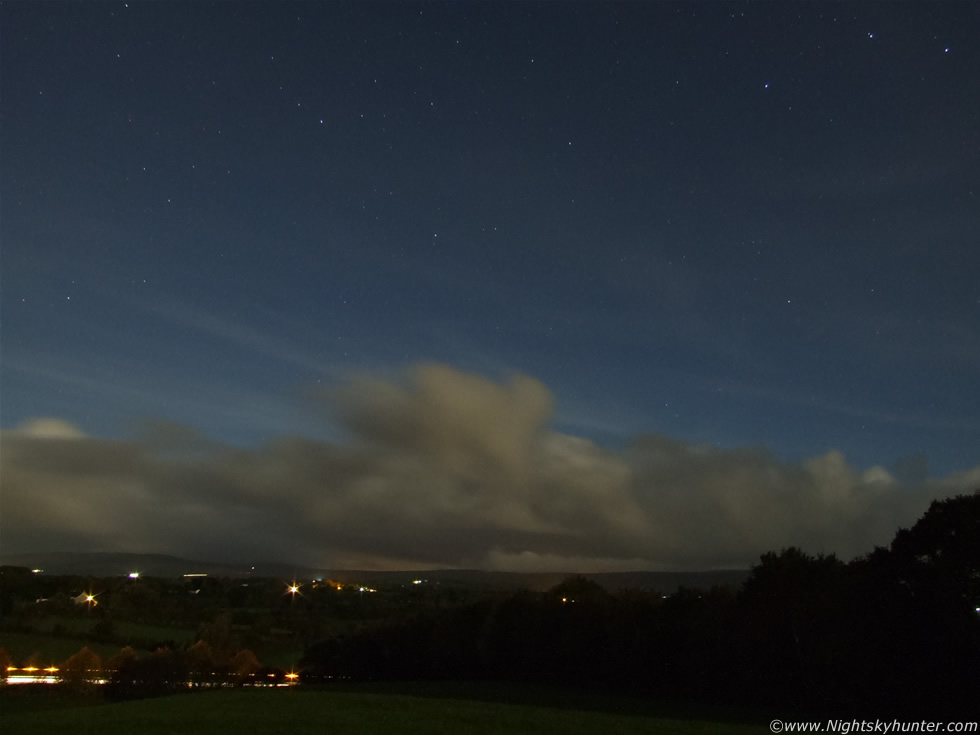

 |
 |
I had this photo session planned three nights in advance. Noting the phase of the Moon combined with the short range forecast I felt sure the conditions would be present for moonbow formation on Wednesday October 15th 2008, and possibly again on Thursday the 16th. On Wednesday evening the Moon would be one day past full phase and rising soon after sunset. The forecast predicted a number of showers which where expected to blow in from the Atlantic Ocean on a cool NWly air mass. These scattered showers where expected over W and NW regions of N. Ireland.
On the 15th I watched the Sun quickly set in the SW and not long after I could see the brilliant crisp lunar disk above the NE horizon sporting a pale lemon colour. It looked so peaceful hanging in the sky within the Earth's shadow. Above was the pink band known as the 'Belt of Venus' which soon faded as it blended in with the darkening sky. I checked the online radar and found what I was looking for. A cluster of showers could be seen many miles away to my W and NW with blue and green returns. They were only weak showers but they would be enough to generate a moonbow if the timing was correct. Armed with this simple information I then decided to head out.
I decided to set-up the gear at the location where I like to image thunderstorms from. Here, on very high ground, I have a splendid view of the surrounding mountains and the town itself. It was perfect. I was facing W in the direction the radar showed showers although none could be seen yet. Behind me in the E was the Moon. Some high level cloud had subdued it's full magnitude but on the plus side it was climbing slowly higher by the minute so things should improve with time. Now it was a waiting game. I took some time to take in the gorgeous view. All around me the stars could be seen so I did my usual dome search. That means doing a detailed naked eye scan of the entire sky incase a bright Nova, or even Supernova, had suddenly erupted. I had left home at 19.00 BST and now it was 20.00. I watched a few Iridium flares and the periodic fireworks which exploded in the distance over the town. I kept alternating between checking the W and E sky for the correct ingredients. The potential was good.
To pass the time I took some images to get the feel for the sky brightness and camera. I closed the aperture down to F/8 and tried to catch some car trails. This is the view spanning from S to SW. All those lights belong to my home town of Maghera. The mountains in the distance are the Sperrins. The car trails mark the location of the Coleraine Road. It was extremely busy tonight. I should draw attention to the fact that this is not twilight. It's full darkness. That bright sky is caused by bright moonlight. Now, where are those showers?
 |
The sky was alot more fun to 'shoot' now with a combination of good clear sectors and scattered cumulus clouds. This is looking SW to W over the Sperrins. Those clouds are moving towards the camera. The distant clouds over the hills were producing precipitation so things were looking positive. Again, you can see the tail lights of the cars along the Coleraine Road which is located behind that tree line. The road was so busy that I had probably caught car trails on every image I took. This image was taken at ISO 200. A value of 400 caused 'burn out' so I made this my main foundation for the images to come. The white trail on the mountain itself marks the main road up the Glen Shane Pass. How well do you know your stars?. From R to L is Bootes with Arcturus, Serpens Caput, and Ophiuchus.
For a period of time things got very frustrating. I had plenty of rain in the correct location but now the Moon was covered with cloud. If only it would pop out. I was actually talking to the sky out loud saying ''come on Moon..come out!'' I would have seen a bow no problem but it didn't happen. A long line of cloud from the NW had it's sights on the Moon which kept it under cover for a long period. The rain was fairly heavy at this stage so I took shelter under trees. I left my tripod where it was standing because it was perfectly aligned with respect to the uneven ground. I was freezing and cold within 5 min's. I've been under much more intense torrential rain from the t-storms during the Summer but this was different. The rain drops felt icy, and combined with the NW breeze it was very uncomfortable.
|
20.36 (All times BST). Now the action begins. This line of weak convection arrived over the Sperrins in the NW and began moving closer. It had quite an intense area of precip underneath which you can see falling over the mountains. The Moon was bright behind me so the conditions couldn't be better. Now I just had to wait for the precip area to get closer and I felt certain I would catch a moonbow. The cloud tops looked great being lit bright white by the Moon. The clear sky with stars aloft was the icing on the cake. The bright star above the clouds is Arcturus. There's a star to the upper L of it which shouldn't be there. That star was an Iridium flare, but not the usual kind. It appeared out of nowhere and flashed for an instant before fading just as fast which is why it's not trailed on this exposure. Canes Venatici and Ursa Major are to the R. Corona Borealis at top centre, and Serpens Caput to the L.
 |
20.43. Success!!!. Moonlight hit the precp and a moonbow suddenly formed. At first it was a faint red patch at tree level then it grew rapidly in height. I began to take alot of images at this stage. It had great form as it continued to grow in height as the precip came closer. I was delighted to have caught Arcturus directly under the bow. The star is in a clear slot however there's light rain falling between it and me. The red colour was quite distinctive.
|
20.47. I backed up the hill to take in more of the bow. Thought I would step in for this one. Look how red my hand is. It was freezing! Just to prove that moonbows always form in the sky opposite the Moon, look at my shadow on the grass.
 |
20.48. This was my favourite image from the session. The NW section of the bow is over the Sperrins and the SW section is not far from Maghera. Ophiuchus is to the L. Nice wispy tops on those clouds. I could see all three colours with the naked eye with ease. This was my last image of the night. The showers seemed to die out and the Moon had climbed higher so I ended the session at 21.30. I went home on a high. I was delighted to see these special moonbows again. This feeling of satisfaction was even more heightened by the fact that I had planned this night three nights in advance. Rarely plans work out, however this time everything came together as expected. I was extremely happy with the images because I think they are probably the best night sky images I have taken to date. I managed to get the focus and exposure perfect for the conditions at the time. This is something which is not easy with a sky which is changing all the time. Back home I was already looking at the forecast for the following night and was thinking about another photo session. It was a pleasurable 2.5 hours out under the mysterious night sky!
On Thursday October 16th I was undecided about what I was doing that evening. The television forecast wasn't showing much in the way of showers because they where expected to retreat to northern coastal regions after dark, however when I checked the radar again I seen a different picture. There where more showers than on the previous night and they looked more intense. I looked out the window and seen the yellow glow of moonlight on some upper level cloud so I made up my mind and decided to go for another session. Could I be so lucky to get moonbows two nights in a row?. I left home at 19.20 BST and headed for the same location as the night before.
 |
19.57. The weather situation was exactly the same as the previous night. Very cold, wet, NWly breeze with showers moving in from the NW. This time the Moon had waned further and was now two days after full phase so there would be less light to work with. Due to the Moon's eastward movement along the ecliptic each night it rises approximately 50 min's later than on the night before. There's some variation on this time depending on the season and angle of the ecliptic with respect to the E or NE horizon. Considering that I was out during the same window period I would be dealing with a Moon which was less bright and lower in the sky. That was the situation when I took the above image. The Moon was low and barely illuminated these cumulus clouds over the mountains. These were starting to produce precipitation so I was ready for round two.
 |
20.05. I began taking a sequence of images as the convection moved in. Below centre there's a nice structure like a curved, dark, semi circular feature with heavy precip behind, probably a small gust front. The Moon had rose a little higher now. You can tell this by how much brighter the clouds are. The sky is darker above, with more stars, all due to a difference of one day in lunar phase. Alcor and Mizar are well defined on the image. Looking NW.
PAGE 2 > |
Martin McKenna